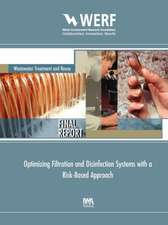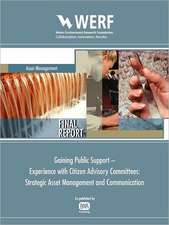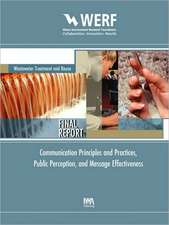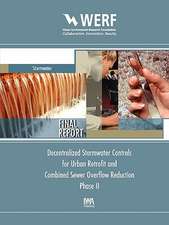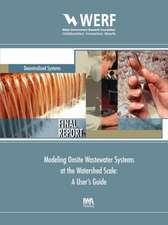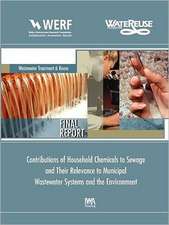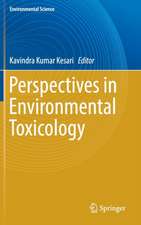The History, Use, Disposition and Environmental Fate of Agent Orange
Autor Alvin Lee Youngen Limba Engleză Paperback – 23 aug 2016
The United States Department of Defense has had the major role in all military operations involving the use of tactical herbicides, including that of Agent Orange. This included the Department's purchase, shipment and tactical use of herbicides in Vietnam, its role in the disposition of Agent Orange after Vietnam, its role in conducting long-term epidemiological investigations of the men of Operation RANCH HAND, and its sponsorship of ecological and environmental fate studies. This book was commissioned by The Office of the Deputy Under Secretary of Defense (Installations and Environment) with the intent of providing documentation of the knowledge on the history, use, disposition and environmental fate of Agent Orange and its associated dioxin.
| Toate formatele și edițiile | Preț | Express |
|---|---|---|
| Paperback (1) | 754.46 lei 6-8 săpt. | |
| Springer – 23 aug 2016 | 754.46 lei 6-8 săpt. | |
| Hardback (1) | 627.65 lei 6-8 săpt. | |
| Springer – 28 apr 2009 | 627.65 lei 6-8 săpt. |
Preț: 754.46 lei
Preț vechi: 920.06 lei
-18% Nou
Puncte Express: 1132
Preț estimativ în valută:
144.39€ • 152.33$ • 120.33£
144.39€ • 152.33$ • 120.33£
Carte tipărită la comandă
Livrare economică 02-16 ianuarie 25
Preluare comenzi: 021 569.72.76
Specificații
ISBN-13: 9781493950935
ISBN-10: 1493950932
Pagini: 360
Ilustrații: XVIII, 339 p.
Dimensiuni: 155 x 235 x 19 mm
Greutate: 0.5 kg
Ediția:Softcover reprint of the original 1st ed. 2009
Editura: Springer
Colecția Springer
Locul publicării:New York, NY, United States
ISBN-10: 1493950932
Pagini: 360
Ilustrații: XVIII, 339 p.
Dimensiuni: 155 x 235 x 19 mm
Greutate: 0.5 kg
Ediția:Softcover reprint of the original 1st ed. 2009
Editura: Springer
Colecția Springer
Locul publicării:New York, NY, United States
Cuprins
Vietnam and the Agent Orange Controversy Revisited.- A History of the Development and Procurement of Tactical Herbicides.- The Military Use of Tactical Herbicides in Vietnam.- Removal from Vietnam and Final Disposition of Agent Orange.- Agent Orange and its Dioxin Contamination.- The Testing of Aerial Spray Equipment, and Ecological Impacts of the Programs at Eglin Air Force Base, Florida.- Monitoring Studies of Former Agent Orange Storage Sites in Mississippi and Johnston Island.- Agent Orange and Dioxin Remediation and the Return to Vietnam.
Recenzii
From the reviews:
“This book is a distillation of thousands of pages of written government and scientific documents, oral histories, spraying records, medical records, and pictures and is organized into eight chapters … . Young presents a dispassionate review, a feat difficult for anyone who touches this sensitive topic and especially laudable for an author who has devoted a major portion of his professional career to the subject over 40 years. … Thank you, Dr. Young, for this much-needed book.” (Mitchell D. Erickson, Environmental Sciences and Pollution Research, Vol. 17, March, 2010)
“This book is a distillation of thousands of pages of written government and scientific documents, oral histories, spraying records, medical records, and pictures and is organized into eight chapters … . Young presents a dispassionate review, a feat difficult for anyone who touches this sensitive topic and especially laudable for an author who has devoted a major portion of his professional career to the subject over 40 years. … Thank you, Dr. Young, for this much-needed book.” (Mitchell D. Erickson, Environmental Sciences and Pollution Research, Vol. 17, March, 2010)
Notă biografică
For 40 years, Dr. Alvin L. Young has collected documents, reports, and photographs on the use, disposition, and environmental fate of Agent Orange and other tactical herbicides used in the Vietnam War. He has published or edited four books and more than 70 peer reviewed publications, commentaries, and editorials on the herbicides (and the associated dioxin contaminant) used in Vietnam. He completed his Ph.D. in Herbicide Physiology and Environmental Toxicology at Kansas State University in 1968. He began his Air Force career as a Project Scientist with the United States Air Force in 1968, evaluating both the dissemination characteristics of the Air Force aircraft and the fate of the herbicides used in South Vietnam. In his 21 years with the Air Force (obtaining the rank of Colonel), he was involved with all phases of the Agent Orange controversy, from test and evaluation of equipment to environmental fate and health impacts. During his years as Associate Professor at the United States Air Force Academy (1971-1977), Colorado Springs, Colorado, he conducted studies on the environmental fate of TCDD including studies on the biodegredation of massive quantities of Agent Orange.
From 1977-1983, Dr. Young was affiliated with the Epidemiology Division, The School of Aerospace Medicine, Brooks AFB, Texas, and the Environmental Epidemiology Unit of the Department of Veteran Affairs, Washington, D.C. His primary responsibilities were the documentation and establishment of exposure assessment protocols for the epidemiological studies of Vietnam Veterans. From 1983-87, Dr. Young was assigned to the Executive Office of the President, where he provided advice to the White House on the issues of Agent Orange and dioxins. From 1987-1997, he was a Science Advisor for the United States Department of Agriculture. From 1997-2001, he was the Director, Center for Risk Excellence, United States Department of Energy, Argonne, Illinois. From 2002 through2007 he was a Visiting Professor and Senior Fellow with the Institute for Science and Public Policy, University of Oklahoma, Norman, Oklahoma. He currently is President, A.L. Young Consulting, Inc., Cheyenne, Wyoming. His scientific specialty is the use, toxicology, and human and environmental risks associated with the military herbicides used in South Vietnam, 1961-1972.
Dr. Young has traveled, lectured, attended and sponsored conferences and workshops in 32 countries speaking on issues related to Agent Orange and TCDD, ecological studies, environmental toxicology, and biotechnology. He has served as a co-editor for four different journals and has more than 300 publications in the scientific literature. He is currently the Editor-in-Chief of the International Journal Environmental Science and Pollution Research. He maintains a Special Collection on Agent Orange at the USDA's National Agricultural Library, Beltsville, Maryland, at http://www.nal.usda.gov/speccoll/findaids/agentorange/index.htm.
From 1977-1983, Dr. Young was affiliated with the Epidemiology Division, The School of Aerospace Medicine, Brooks AFB, Texas, and the Environmental Epidemiology Unit of the Department of Veteran Affairs, Washington, D.C. His primary responsibilities were the documentation and establishment of exposure assessment protocols for the epidemiological studies of Vietnam Veterans. From 1983-87, Dr. Young was assigned to the Executive Office of the President, where he provided advice to the White House on the issues of Agent Orange and dioxins. From 1987-1997, he was a Science Advisor for the United States Department of Agriculture. From 1997-2001, he was the Director, Center for Risk Excellence, United States Department of Energy, Argonne, Illinois. From 2002 through2007 he was a Visiting Professor and Senior Fellow with the Institute for Science and Public Policy, University of Oklahoma, Norman, Oklahoma. He currently is President, A.L. Young Consulting, Inc., Cheyenne, Wyoming. His scientific specialty is the use, toxicology, and human and environmental risks associated with the military herbicides used in South Vietnam, 1961-1972.
Dr. Young has traveled, lectured, attended and sponsored conferences and workshops in 32 countries speaking on issues related to Agent Orange and TCDD, ecological studies, environmental toxicology, and biotechnology. He has served as a co-editor for four different journals and has more than 300 publications in the scientific literature. He is currently the Editor-in-Chief of the International Journal Environmental Science and Pollution Research. He maintains a Special Collection on Agent Orange at the USDA's National Agricultural Library, Beltsville, Maryland, at http://www.nal.usda.gov/speccoll/findaids/agentorange/index.htm.
Textul de pe ultima copertă
For almost four decades, controversy has surrounded the tactical use of herbicides in Southeast Asia by the United States military. Few environmental or occupational health issues have received the sustained international attention that has been focused on Agent Orange, the major tactical herbicide deployed in Southern Vietnam. With the opening and establishment of normal relations between the United States and the Socialist Republic of Vietnam in 1995, the time has come for a thorough re-examination of the military use of Agent Orange and other "tactical herbicides" in Southern Vietnam, and the subsequent actions that have been taking place since their use in Vietnam.
The United States Department of Defense has had the major role in all military operations involving the use of tactical herbicides, including that of Agent Orange. This included the Department's purchase, shipment and tactical use of herbicides in Vietnam, its role in the disposition of Agent Orange after Vietnam, its role in conducting long-term epidemiological investigations of the men of Operation RANCH HAND, and its sponsorship of ecological and environmental fate studies. This book was commissioned by The Office of the Deputy Under Secretary of Defense (Installations and Environment) with the intent of providing documentation of the knowledge on the history, use, disposition and environmental fate of Agent Orange and its associated dioxin.
The United States Department of Defense has had the major role in all military operations involving the use of tactical herbicides, including that of Agent Orange. This included the Department's purchase, shipment and tactical use of herbicides in Vietnam, its role in the disposition of Agent Orange after Vietnam, its role in conducting long-term epidemiological investigations of the men of Operation RANCH HAND, and its sponsorship of ecological and environmental fate studies. This book was commissioned by The Office of the Deputy Under Secretary of Defense (Installations and Environment) with the intent of providing documentation of the knowledge on the history, use, disposition and environmental fate of Agent Orange and its associated dioxin.
Caracteristici
Includes supplementary material: sn.pub/extras

